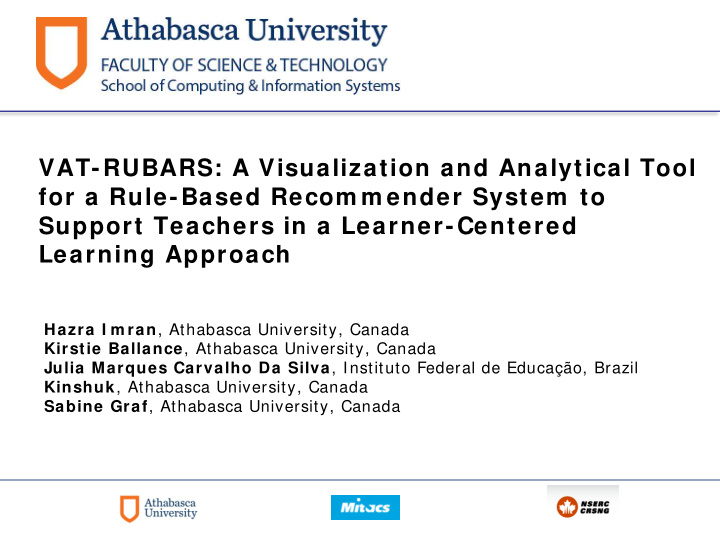



VAT-RUBARS: A Visualization and Analytical Tool for a Rule-Based Recom m ender System to Support Teachers in a Learner-Centered Learning Approach Hazra I m ran , Athabasca University, Canada Kirstie Ballance , Athabasca University, Canada Julia Marques Carvalho Da Silva , Instituto Federal de Educação, Brazil Kinshuk , Athabasca University, Canada Sabine Graf , Athabasca University, Canada
Motivation Learner-centered learning has many advantages such as enabling students to focus on their interest empowering learners on how and what to learn motivating learners promoting active learning enhancing learners performance 2
Motivation One way of providing students with a learner-centered approach is to allow them to chose which tasks of an assignment they do Accordingly, learners can choose, for example, to do many easy tasks or only a few difficult tasks (in order to achieve full marks) However, there are two main concerns with such pedagogy: While having choice is a great motivator for students, it sometimes might be difficult for students to actually make a meaningful selection of tasks addressed in previous research by creating a recommender system While a learner-centered approach has a lot of advantages for students, it makes it difficult for teachers to understand what is going on in their courses and to monitor what their students are doing focus of this paper 3
Research Question How to support teachers in a learner- centered approach using learning analytics and visualizations? Build a tool that provides teachers with information about students’: Performance in each unit Performance on each task Submission statistics Acceptance of recommendations for each task Acceptance of recommendations for each units Integrate the tool into an LMS 4
Background on learner-centered approach and recommender system For each assignment in the course, students can select between easy, moderate and difficult tasks For each tasks, they get points based on its difficulty level (e.g., more points for difficult tasks, less points for easy tasks) Overall, they need to target a certain number of points for each assignment The recommender system uses the following information to provide students with recommendations on which tasks to do for a given assignment: The student’s past grades on previous assignments in the course The grades of similar students (based on learning styles, expertise level and prior knowledge) on tasks of the given assignment The students’ plan on which tasks to do for the given assignment 5
VAT-RUBARS Visualizes information for teachers in different tabs Allows teachers to see information for all students, one particular student or a group of students Teachers can select groups of students based on: Prior knowledge on core topics of the course Expertise level Learning styles Teachers can also limit the information to particular units or tasks with particular difficulty levels (e.g., only difficult tasks) 7
VAT-RUBARS 8
Unit-Related Performance Shows average grade per unit for all learners, an individual learner or a group of learners Shows overall average grade of the whole class Helps teachers to get a general overview on the performance in each unit 9
Task-Related Performance Shows average performance of each task for all learners, an individual learner or a group of learners Low, medium and high performance is highlighted through colors (thresholds for low, medium and high can be set by teachers) Number of tasks with each difficulty level is indicated Helps teachers to see tasks on which students do very well or not so well, as well as to check the difficulty levels of tasks 10
Submission Statistic Shows how often tasks have been submitted by all learners, an individual learner or a group of learners Low, medium and high number of submissions are highlighted through colors (thresholds for low, medium and high can be set by teachers) Helps teachers to see which tasks are more popular and which are submitted only rarely 11
Task-Wise Recommendation Acceptance Shows more detailed information on the selection of tasks for all learners, an individual learner or a group of learners. More concretely, it shows: How often/ whether a task has been selected in learners’ initial plan How often/ whether a task has been recommended by the system How often/ whether a task has been submitted Helps to see why tasks have been selected and whether students follow the recommendations provided by the recommender system 12
Learner-Wise Recommendation Acceptance Shows how often all learners, an individual learner or a group of learners accepted recommendations from the recommender system for each unit Helps to understand whether or not students follow the recommendations provided by the recommender system 13
Conclusion VAT-RUBARS aims at supporting teachers by providing them with functionality to reflect on their teaching practices in courses that apply a learner-centered design Future work: Adding a recommendation component for teachers which provides teachers with recommendations based on the information currently presented to them (e.g., check task 1.4 as it is classified as easy tasks but students’ performance on this task is quite low, etc.) 14
Questions 15
Recommend
More recommend